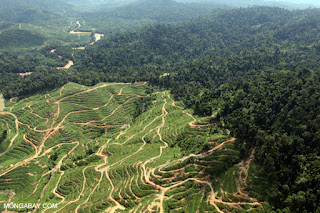Week 10 - Palm oil
Palm Oil
Having looked at different types of fats, their uses in living organisms and explored the causes and implications of obesity the final week is going to focus on one source of lipids that has seen a dramatic increase in demand and is having a devastating effect on the environment.
Palm oil accounts for two-thirds of internationally traded vegetable oils. Worldwide, over 54 million tonnes of palm oil were produced in 2013. It is used in a plethora of food and cleaning products. You’ll find it in peanut butter, ready-made pizzas and shampoos. It’s used because it’s cheap to produce and has a longer shelf-life than other oils. The downside to all this cheap oil is that millions of hectares of rainforest have been converted to palm oil plantations, posing a major threat to biodiversity.
It’s not just charismatic animals like orang-utans that lose their habitats. Each 1,000 hectares of rainforest is estimated to be home to 750 tree species, 400 bird species and 150 butterfly species. In the EU, new food labelling regulations introduced in 2014 mean that manufacturers can no longer hide the presence of palm oil in their products under the generic term ‘vegetable oils’. Two major producers of palm oil, including the world’s largest, have committed to zero deforestation policies, while manufacturers are pledging to use sustainable palm oil or stop using it altogether under voluntary agreements.
Task:
Having looked at different types of fats, their uses in living organisms and explored the causes and implications of obesity the final week is going to focus on one source of lipids that has seen a dramatic increase in demand and is having a devastating effect on the environment.
Palm oil accounts for two-thirds of internationally traded vegetable oils. Worldwide, over 54 million tonnes of palm oil were produced in 2013. It is used in a plethora of food and cleaning products. You’ll find it in peanut butter, ready-made pizzas and shampoos. It’s used because it’s cheap to produce and has a longer shelf-life than other oils. The downside to all this cheap oil is that millions of hectares of rainforest have been converted to palm oil plantations, posing a major threat to biodiversity.
It’s not just charismatic animals like orang-utans that lose their habitats. Each 1,000 hectares of rainforest is estimated to be home to 750 tree species, 400 bird species and 150 butterfly species. In the EU, new food labelling regulations introduced in 2014 mean that manufacturers can no longer hide the presence of palm oil in their products under the generic term ‘vegetable oils’. Two major producers of palm oil, including the world’s largest, have committed to zero deforestation policies, while manufacturers are pledging to use sustainable palm oil or stop using it altogether under voluntary agreements.
Task:
- Carry out some of your own research into palm oil. Bullet point 3 facts you find out below along with any useful website links.
- Do you think should palm oil production be banned altogether? Explain your opinion in the comment section below. Please be respectful of other peoples opinions and sensitive to others views.






